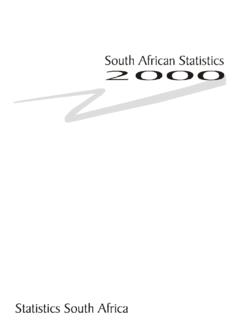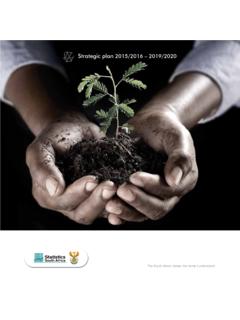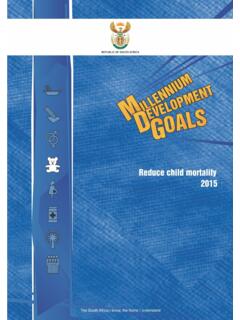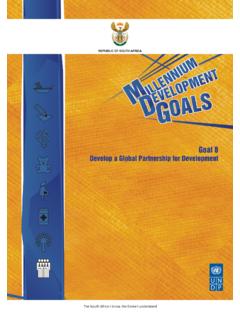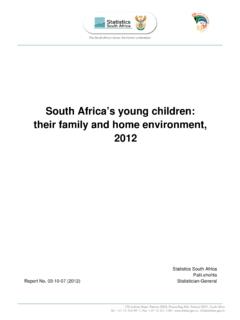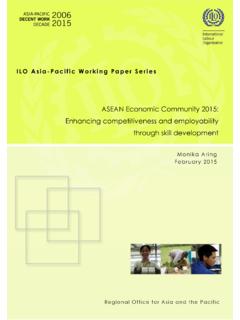Transcription of SOCIO-ECONOMIC INDICATORS OF …
1 SOCIO-ECONOMIC INDICATORS OF development progress within THE OECD FRAMEWORK IN SOUTH AFRICA Eric O. Udjo, Sandile Simelane, Desmond BooysenStatistics South AfricaPrivate Bag X44 Pretoria 0001 Paper presented at the Millenium Conference of Commonwealth Statisticians, Gaborone, Botswana, 1-5 May, economic INDICATORS OF development progress within THE OECD FRAMEWORK IN SOUTH AFRICA ABSTRACTI nternational organisations have developed or proposed SOCIO-ECONOMIC INDICATORS to measure development progress across countries. In addition to meeting international obligations, there have been a number of initiatives in South Africa to develop INDICATORS that take into consideration the country s specific needs. As the official agency for the collection of national statistics, Statistics South Africa has played a crucial role in the development of indictors in South Africa including the compilation of the core set of 21 INDICATORS within the framework of the Organisation of economic Co-orporation and development (OECD)/World Bank/United Nations initiative.
2 This paper provides background information on broad economic INDICATORS in South Africa. In addition, the paper situates the levels of SOCIO-ECONOMIC development in South Africa within the framework of the OECD/World Bank/United Nations core set of INDICATORS OF development progress within THE OECD FRAMEWORK IN SOUTH AFRICABACKGROUNDI nternational Initiatives in measuring and monitoring developmentThe development , regular compilation and publication of some objective quantitative and qualitative criteria ( INDICATORS ) are necessary to measure, monitor and inform policies with regard to SOCIO-ECONOMIC development in any country. A number of initiatives have been undertaken in this regard internationally. Williams and Smith (2000) provide a comprehensive review of such initiatives, which include:The United Nations (UN) Minimum National Social Data Set (MNSDS);The UN Basic Social Services for All (BSSA);The Organisation for economic Co-operation and development (OECD) development Assistant Committee (DAC)/World Bank/UN s working core set of INDICATORS of development progress (IDP);United Nations development Assistance Framework s Common Country Assessment INDICATORS (CCA);International Monetary Fund s (IMF) General Data Dissemination System (GDDS) and Special Data Dissemination Standard (SDDS);The Word Bank s Comprehensive development Framework (CDF), Highly Indebted Poor Countries (HIPC) and Poverty Reduction Strategy Plans (PRSP).
3 The INDICATORS that have been developed or proposed internationally overlap. The initiatives emphasise cross-country comparison through uniform methods and definitions in the computation of the INDICATORS . In a series of UN global conferences there was concern on major development issues including education (Jomtien, Thailand, 1992), children (New York, 1990), the environment and development (Rio de Janeiro, 1992), population and development (Cairo, 1994), social development (Copenhagen, 1995) and women (Beijing, 1995). In response to these issues, in 1996, development ministers of OECD countries formulated a strategy for development based on seven international goals. These were the priorities to be achieved before 2015 in order to improve the quality of life in developing countries. The goals are in the fields of economic well being, social development and the environment as follows:Reduction by half of proportion of people living in extreme poverty by 2015,Universal primary education by 2015,Elimination of gender disparity in primary and secondary education by 2005,Reduction of infant and child mortality by two-thirds the 1990 levels by 2015,Reduction of maternal mortality by three-fourths the 1990 level by to reproductive health services through the primary health-care system for all individuals of appropriate ages, including safe and family planning methods by 2015,Reversal of trends of loss in environmental resources by 2015,(see OECD, 1998, 2000).
4 To assess progress with regard to the goals indicated above, a core set of 21 INDICATORS ( INDICATORS of development progress , (IDP) was defined by OECD DAC, World Bank and the UN. In addition to monitoring progress in various fields of development , the core INDICATORS provide a yardstick for assessing the effectiveness of strategies in those fields. (OECD, 1998). However, aggregate measures such as the IDP and other international INDICATORS do not adequately reflect the diversity of a country s population including South Africa. Measuring and monitoring development in South AfricaAlthough South Africa is a member of the international development partnerships strategy, in addition to meeting international obligations there have been national initiatives to develop INDICATORS that take into consideration, the country s specific needs with regard to the monitoring of transformation of hitherto apartheid South Africa. The goals of transformation are embodied in Government s Reconstruction and development Programme (RDP), and the Growth, Employment and Redistribution (GEAR) strategy.)
5 The RDP is an integrated, coherent SOCIO-ECONOMIC policy framework and its programme of action is structured around its principal policy thrusts, which brings together clusters of Ministries and Departments (Republic of South Africa, 1998; Department of Welfare, 1998). Five major policy programmes have been linked. These are designed to meet the overall goal of the RDP - a better life for all namely: meeting basic needs, developing the country s human resources, building the economy, democratizing the State and Society, implementing the RDP (Republic of South, 1998).On the other hand, GEAR is the government s macro- economic framework for rebuilding and restructuring the economy; it complements the RDP (Republic of South Africa, 1998; Department of Health, 1998). The twin objectives of the GEAR are transformation of the economy to meet the needs of the new democracy, and gearing it for the competitive world economy. The Strategy in place to achieve the objectives includes infrastructure development (including housing, health care and education facilities, municipal and rural infrastructure, and recreational facilities); measures to promote competitiveness and employment; restructuring of state assets; fiscal and financial discipline and the reprioritising of spending (Republic of South Africa, 1998).
6 The development , regular compilation and reporting on INDICATORS in these areas are essential to monitoring changes, and informing policies regarding transformation in South Africa. It is against this background that INDICATORS have been defined or proposed in South Africa. Some of the efforts in this regard are reviewed below. A REVIEW OF INITIATIVES IN THE development OF INDICATORS IN SOUTH AFRICAA rising from a workshop in 1999 regarding people s opinions about transformation in South Africa, Hercules (1999) identified areas in which "people s" INDICATORS should be developed to measure progress in transformation. According to Hercules, measures of transformation should go beyond the existing conventional and national-level INDICATORS . He argues that people s INDICATORS allow for a close face-to-face exploration of the reality of ordinary South Africans, which goes beyond the limitations of the annual October household survey (OHS).
7 He proposed 47 key INDICATORS covering 8 broad areas namely: the economy, social trends, the environment, attitudes and values, politics, process, participation, personal freedom and growth. Hercules does not provide definitions and data sources for these the other hand, the Department of Health (1999) was explicit in defining INDICATORS for the health sector with regard to definitions, data sources and responsibilities. They defined over one hundred INDICATORS that are measurable through existing and planned information systems. The Department s INDICATORS are intended to monitor progress toward achieving the year 2000 health goals and objectives. The INDICATORS cover maternal, reproductive and women s health; child health; adolescent health; care of older persons; nutrition; oral health; environmental health; occupational health; emergency health services; human resource development ; substance abuse; mental health; disability; sexually transmitted diseases and HIV/AIDS; chronic diseases; technology policies; drug policy; national information system; health a member country of SADC, South Africa has played a role in proposing benchmark INDICATORS for essential data collection in monitoring health management and health status in the SADC region.
8 The 34 benchmark INDICATORS proposed cover the following areas: health status; equity in health; quality of services; cost efficiency; customer/client satisfaction; transparency, ownership and partnership in health (see, SADC Surveillance , undated). Poverty alleviation, a critical issue in the transformation process, is a major concern to the Government. In this regard, the Cabinet instructed that all poverty work be co-ordinated by the Policy Co-ordination and Advisory Services unit (POCAS) formerly called the Co-ordination and Implementation Unit (CIU) in the Presidency. To ensure the success of Government s policies and programmes on poverty, the Poverty and Inequality INDICATORS and Monitoring Task Team (PIIM) in conjunction with the CIU held a workshop in 1998, to define and identify INDICATORS that are best suited for measuring and monitoring poverty. Four types of poverty INDICATORS were identified: Impact of policies/programmes and process INDICATORS ; input/output INDICATORS ; participation and empowerment INDICATORS ; and cost INDICATORS .
9 The workshop recommended that a team be appointed to identify INDICATORS from each of the following categories:Population and housing characteristics;Access to services;Resources, assets and opportunities;Institutional arrangements;Rights, responsibilities and choices; more details, see Report of the technical workshop on poverty INDICATORS measurement and monitoring, other Government Departments have developed poverty monitoring INDICATORS including the Departments of Agriculture, Constitutional development , Education, Environmental Affairs and Tourism, Housing, Labour, Land Affairs, Public Works, Transport and Statistics South Africa (See Thorne-Erasmus, 1998 for a more detailed review). The role of Statistics South AfricaAs the official agency for the collection of national statistics, Statistics South Africa (Stats SA) has played a crucial role in the development of INDICATORS as follows: participation in various forums developing INDICATORS including some of those listed above; development of its own INDICATORS ; compilation and publication of various INDICATORS based on its regular surveys and the population relation to (2) above, Stats SA uses the following INDICATORS for monitoring living conditions in South Africa: living in formal housing, access to electricity for lighting, tap water inside the dwelling, a flush or chemical toilet, telephone in dwelling, regular refuse removal, level of education of household head, average household size, children less than five years old, annual income and unemployment.
10 In addition, Stats SA has constructed two development indices household infrastructure index and household circumstances index to enable equitable allocation of resources, and monitor change in the life circumstances of people in different areas of South Africa. (See Orkin, Hirschowitz, Alberts and Lehohla, 1999). As a means of improving the country s labour market statistics including employment and unemployment INDICATORS , Stats SA recently introduced a bi-annual labour force survey (LFS). The first of these surveys was implemented in February 2000, and is currently being processed for analysis. Additionally, Stats SA has played a key role in co-ordinating the compilation of the core set of 21 INDICATORS of development progress within the framework of the OECD DAC, World Bank and the UN initiative. Stats SA is also responsible for the provision of specific core INDICATORS . This is discussed in the next conclude this review, the following may be noted.
